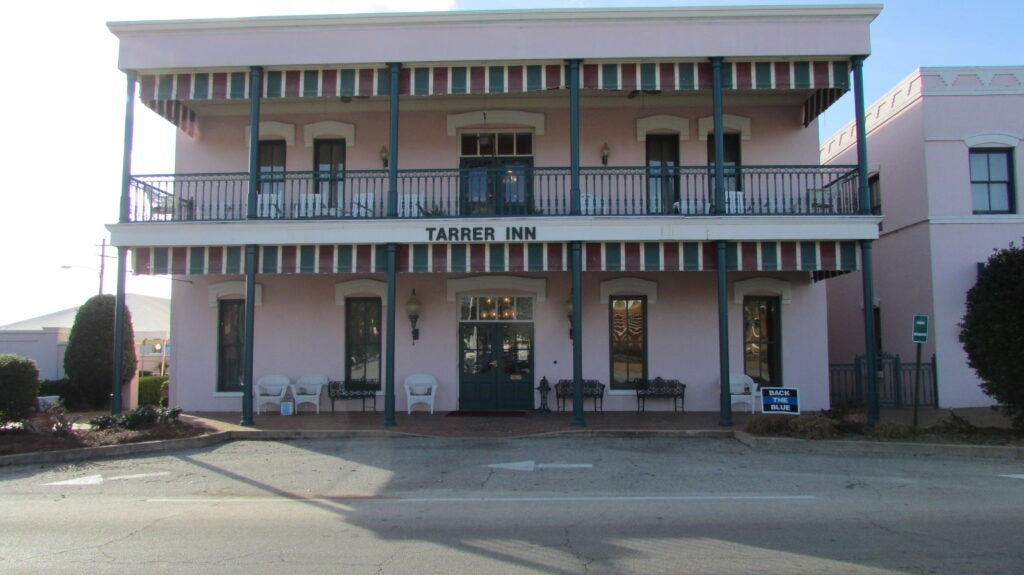Preserving Precious History
Published 1:08 pm Sunday, March 17, 2024
|
Getting your Trinity Audio player ready...
|
On the southwest corner of Colquitt’s town square, stands an eye catching, but faded, tropical pink building, the historic Tarrer Inn. It attracts your attention and makes you wonder, what is inside?
Unfortunately, we cannot enter because there was major damage to this wonderful building during Hurricane Michael. The current owner is now renovating the Inn and construction is taking place all over, bringing the building back to life.
Fortunately, I have been inside the hotel in the past and I will share its story with you today. I am forever grateful when I can say, “I knew it when”.
Everything started way back, in 1860, when the land where the Tarrer Inn is now located was deeded as a wedding gift to Dr. William Elijah Hunter and his bride, Chloe Bush. It was originally built as a large, wooden, private dwelling. Then, in 1861, with so many men walking to and from battles during the War Between The States, it became a boarding house.
In 1902, this large home became known as the Hunter House. However, on July 20th, around three o’clock in the morning, a fire broke out in one of the buildings that was in downtown Colquitt. The whole community responded to the call and did the best they could to put this fire out. However, when the smoke cleared, the town was in ashes, especially the north and west sides, which were completely destroyed. Listed among these buildings was the home owned by Dr. and Mrs. Hunter, their Hunter House.
This added story is about what happened during the fire that involved the Hunters and is one that has been passed down through generations. Back in those days there were no banks. Therefore, the Hunter’s kept their money in a large, Saratoga trunk in their bedroom. Their child, Lena Mae Hunter, knew this since someone was required to be in the room with the trunk at all times and she always had a turn.
The night of the fire, everyone was aroused by gun shots, which was the signal that something was wrong. The people were greeted by thick smoke billowing everywhere and flames that were spreading quickly amongst the wooden structures. Everyone who could, went to help in putting out the fire and rescuing folks and their belongings, whenever possible. Chloe Hunter was setting on top the trunk which had been carried across the street to the courthouse lawn. She would not leave her post.
A friend of Chloe’s, Nette Dixon, arrived at the fire and saw her on top of the trunk. Nettie then went to see if she could help. Chloe asked Nette to take her place on top of the trunk, telling her that she was the only other honest woman in Colquitt, and please, don’t leave that trunk. With that said, Chloe went off to rescue other family items.
After this tragedy, all of the buildings on the square had to be rebuilt as brick structures. When the Hunter House was finished, it was said that Dr. Hunter told everyone that he would provide travelers with the best service that can be had anywhere on the road.
Dr. Hunter also owned a drug store that was supplied with medicines to cure many illnesses. This business was thriving but he also needed to keep up with the rebuilding of the hotel. This is when he hired his nephew to be the clerk in the drug store.
By 1915, the Hunter House once again became known as a haven for weary travelers who had made their way to Colquitt. The lady who now ran this hotel was Ma Harrell. Her cooking was a legend, with her fried chicken and yeast rolls known throughout the area. These dishes alone drew many hungry people into the Hunter House. Then, sometime between 1915 and 1920, the structure was purchased by Dr. Peter Wilkin. The Inn became a residence for his family: a wife and ten children.
Sometime in the years around 1920 and 1930, the large Wilkin’s house was bought by Mr. and Mrs. Bill Grow who named the property, the Grow Hotel. One of its tenants was Miss Ollie Lofton Sutton. Born around 1880, she lived for several decades in what was then Room 4, upstairs, on the south side of the building in the front, on the corner.
Ms. Ollie came to Colquitt as a school teacher and took up residence in the Grow Hotel. Right by her room, she had access to a beautiful balcony. It was from here that she watched the changes taking place in Colquitt unfold.
She saw land covered with many trees turn into businesses. She witnessed the traffic of the early 1900s, which consisted of Model T’s and horse and wagons, change into modern pick-up trucks and cars. The courthouse changed before her very eyes from a beautiful, yellow brick building to what she called, “a squat type of building”. It no longer had the gilded tower and the four faced clock that told the time to everyone. She watched as marked off parking spaces took over where hitching posts once stood. With all of the love she had for her home and Colquitt, it isn’t any wonder that her spirit had never left after she passed on.
Her mind stayed bright and clear and in May of 1975, at the age of 95, she told what life was like during the War Between the States, as she was told by her mother.
“Salt was not available. Each family had a smoke house where the meat was smoked. They were made of logs with dirt floors and the meat was hung from roof rafters. During the War, the dirt was taken from the floors and boiled, thus salt water for cooking. There were many “make do” things, such as soap from lye, dyes from berries and thorns for pins. Household linens were made into bandages and sent to the front lines by those who returned to the War after furloughs.
Homes had no locks and though Miller County was not a battlefield, the women and children were constantly alert for deserters and vandals, who were a continuous danger. Whenever possible, men were given furlough to plow and plant and again at gathering time. The tending of the fields along with other domestic chores were done by the women and children at home.”
When I visited, Room 4 was pretty much the same as it was back when Miss Ollie lived there. Those who worked at the Inn had experienced her “take charge” ways as she “oversees” taking care of the Inn. A few instances are: the alarm clock in Room 4 will be blinking when there is no reason and no one has set it. Those who clean the rooms upstairs have heard footsteps in the long, broad hall. Lights will go on and off with no one flicking the switch and in rooms that are entirely empty. Dishes will be rearranged in the kitchen cupboards as well as some antique furnishings moved to other places.
As time went on, the building became harder and harder to keep in good repair. The weather had begun to take its toll on the structure. Bats had found themselves a home in the attic and the plumbing became old and out of date as did the electricity.
No one wanted to see this historic icon lost. Therefore, in 1992, the Grow Hotel was purchased by the Historic Economic Revitalization Organization and an extensive renovation began. It was a major undertaking and took several years for all of the work to be completed.
This was truly a labor of love and the newly renovated structure was called the Tarrer Inn, in memory of Ruth Tarrer Jinks, Clyde Jinks’s mother. Mr. Jinks was the head of a Foundation set up to perpetuate the legacy of his mother. The renovated bed and breakfast opened its doors in September, 1994.
Ms. Ruth was born in 1902. She married G. C. Jinks in 1920. They were married for 67 years. Ruth was known for her love of flowers and the beauty that they brought into people’s lives. Her knowledge of horticulture was respected by everyone who knew her. She was a great patron of the arts and was an accomplished musician herself, playing the piano and the organ for the Colquitt Methodist Church for over 60 years. Her piano was in the downstairs dining hall.
Mr. G. C. Jinks was born in 1900, in Taylor County. During the 1920s, he moved to Miller County. When Mr. Jinks was a teenager, he gained experience in statistics and bookkeeping. In 1927, he became the cashier at the Citizen’s Bank. By 1934, he was elected president of the bank. In 1973, Mr. Jinks became the chairman of the board. He retired in 1984 and passed on in 1990. An active man who loved his community, his generosity has benefitted many colleges and charitable organizations.
The Tarrer Inn has kept its Victorian Southern charm throughout all of the past renovations that have taken place, including the most recent ones completed in the fall of 2017. It truly had that distinct Southern style that makes you think about sunny days and the wonderful scent of flowers. The rooms were done in ornate, antique furnishings which were set off by the vivid colors that now accented the walls. The fabrics recalled the love for velvet traditionally bordered with scallops and tassels. The wide moldings and decorative trim work had been preserved in all the rooms throughout the Inn, a reflection of the past.
When you first open the doors which were the original ones, you would be greeted by the most delicious of scents in Southern cooking. Straight ahead, was a magnificent, wide stairway that led up to where the twelve bedrooms were.
The downstairs was renovated so that there were three dining areas. This was once a parlor for setting and enjoying the fireplace as you were entertained by anyone who wanted to play the piano. Each dining room had paintings and furnishings from the past. There were portraits on the walls of the Jinks family, whose legacy of endowments went towards the building. There were antiques which maintained the Victorian ambience that reminded one of the Old South.
The Tarrer Inn, was just like it was when called the Hunter House, famous for the Southern foods that were served. Many of the recipes were those handed down from another time. On the sidewalk outside, was a chalk board, on which was the menu of the day.
Also, you couldn’t help but see that wide stairway to your right, leading to the upstairs where there was a wide hall that contained a large setting room. The parlor rugs were the originals as were the tables and chairs. All of the antique furniture, lamps, china, photos and charm were preserved.
There also was a chaise lounge that was a popular piece of Victorian furniture in the parlor. This was known as a fainting couch, for the tightly corseted ladies of that era, who at times, had a hard time breathing after climbing the stairs. The secretary desk was probably the finest piece in the setting room. It was crafted in the 1800s, in England, and was made of mahogany. It was used for letter writing, storing valuable books and record keeping.
During the last years of the Victorian era, metal beds became fashionable and there were several throughout the Tarrer Inn. They were molded from iron or brass, giving them a delicate, almost airy look. Also, some of the beds had magnificently carved, ornate headboards.
Each of the bedrooms were decorated in different wallpaper, paint colors and carpeting. They all had private baths that matched the bedrooms.
In 1995, the Tarrer Inn proudly hosted retired President Jimmy Carter, who had come to Colquitt to see the Swamp Gravy plays. Everyone who was working at the Inn at this time remembered how the secret service watched over the Carters.
Through the years there have been several managers. Local sisters Barbie Womble and Toni Chapman were in charge when I was last there. Back then, the number of guest rooms had to be increased and two annexes were acquired.
In 1998, the Tarrer Inn was deeded to the Colquitt/Miller Arts Council, Inc. This is when it was listed on the National Register of Historic Places. The Tarrer Inn also received the prestigious Georgia Trust Award for its renovation and was originally chartered as a museum for the historic significance of the building and the quality of the antiques.
At this time, I was not allowed in, but, when possible, I will go and share how the renovations are coming along. Given Colquitt’s love for its past, I am sure that they are doing their best to preserve the history of this wonderful inn.






